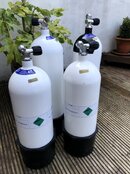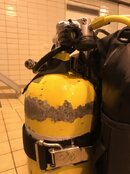I buy all my tanks second hand, and generally when they have expired certs, as this makes them very cheap. So far out of probably 10 i've bought, i've had one that i've scrapped (it was 25 years old and really bashed around and had some internal rust) but the rest have been re-furbishable. As i'm in the UK, i dive with steels so my advice really is specific to those:
1) open it up and look inside. I'd expect either no visual defects and no rust, but a tiny, tiny amount of surface rust is saveable, but will need careful watching. Yes, you can tumble tanks easily enough to clean up the inside, but ime, their resistance to internal rust is much reduced once the original internal anti-corrosion coating has been taken off by the tumbling media.
2) externally, tanks can be totally scratched and knocked to heck and be restored very effectively. Even tanks with what look to have significant corrosion might be saveable because steel tanks are zinc sprayed from the factory, and that zinc is sacrificial, ie the actual steel doesn't start to corrode until most of the zinc is gone.
3) if there is external corrosion of any significance, really, you are going to have to repair, or replace the zinc plating in order to gain any long term protection. The best method is obviously to remove all the existing zinc back to bare steel (aggressive media blast or abrasives) and then have the tanks "cold zinc sprayed" which isn't actually that expensive. However, on a budget, and especially if you dive more fresh water than salt, a very good high zinc content primer will give the tank a stay of exectution. The problem with a paint rather than a metal spray is adhesion, knocks and bangs will lift the primer, allow water underneath an in via micro-cracks and porousity and rust WILL start so you'll have to watch it a bit more carefully
4) i personally use a simple abbrasive sanding technique to remove paint layers back to the one of three positions
a) Remove just the original top colour coat, leave the original primer and zinc - only for the best tanks with no deep scratches or marks. effectively a purely cosmetic refresh
b) Remove the origninal colour coat and the original primer, back to the top of the original zinc metal spray coat. For tanks with little or no damage that is into or through the zinc. Easy to do, because the zinc coat is significantly harder than any of the painted layers, and the colour difference makes the sanding process easy to feather too
c) Remove everything back to bare parent steel.
5) the hardest but important part is to ensure you remove paint from the embossed ID stamping. if you don't, chances are, the new layers of paint will fill these stampings in, rendering them invisible and meaning and instant "rejection" come visual/hydro tume. The method i use is to sand around the stampings, then use a hot air gun to carefully soften the paint actually in the stampings and use a sharp metal pick or wire brush to remove it. This is pretty fiddly and time consuming so if you have access to a a media blasting system then this bit is a LOT easier!
6) Once stripped, and degreased, i repaint with an ultra tough two part marine expoxy. Using a couple of layers of high content zinc primer and then a couple of coats of colour coat to suit. Originally i used to then finish my tanks with a clear UV resistant two part top coat, but found this was too smooth and made the tanks difficult to handle! (although it did look pretty nice

You need a nice thick overal paint coat, certianly probably 3 or 4 times thicker than the tyipcal coating thickness you get from a basic spray can application
When you add up the time and costs involved, and if you haven't got the things like the spray kit and drying oven then it almost certainly isn't worth the effort mostly, unless you are dealling with a simply type A refresh (cosmetic only). However i quite like "saving" old kit, and the process is surprisingly theraputic and satisfying






